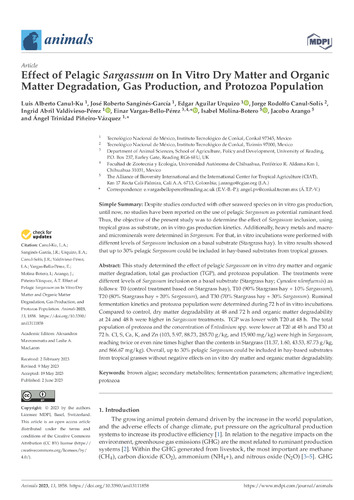Effect of pelagic Sargassum on in vitro dry matter and organic matter degradation, gas production, and protozoa population
This study determined the effect of pelagic Sargassum on in vitro dry matter and organic matter degradation, total gas production (TGP), and protozoa population. The treatments were different levels of Sargassum inclusion on a basal substrate (Stargrass hay; Cynodon nlemfuensis) as follows: T0 (control treatment based on Stargrass hay), T10 (90% Stargrass hay + 10% Sargassum), T20 (80% Stargrass hay + 20% Sargassum), and T30 (70% Stargrass hay + 30% Sargassum). Ruminal fermentation kinetics and protozoa population were determined during 72 h of in vitro incubations. Compared to control, dry matter degradability at 48 and 72 h and organic matter degradability at 24 and 48 h were higher in Sargassum treatments. TGP was lower with T20 at 48 h. The total population of protozoa and the concentration of Entodinium spp. were lower at T20 at 48 h and T30 at 72 h. Cl, S, Ca, K, and Zn (103, 5.97, 88.73, 285.70 g/kg, and 15,900 mg/kg) were high in Sargassum, reaching twice or even nine times higher than the contents in Stargrass (11.37, 1.60, 43.53, 87.73 g/kg, and 866.67 mg/kg). Overall, up to 30% pelagic Sargassum could be included in hay-based substrates from tropical grasses without negative effects on in vitro dry matter and organic matter degradability.

